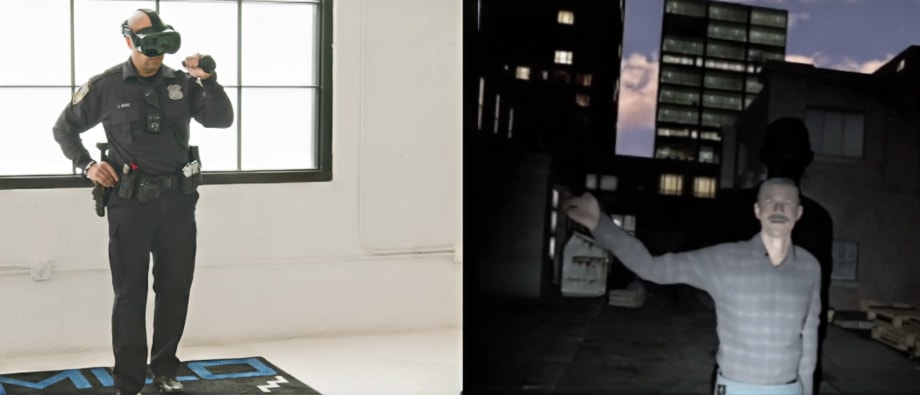Teaching officers how to talk to people while wearing a uniform and a badge of authority has never been a quick process. It’s the kind of thing that comes with experience. Now, a new simulation feature from MILO Range may reduce the length of that communications learning curve.
First Look: Adding AI to Simulator Training
The new artificial intelligence feature for MILO’s VR and Focus3D simulators gives trainees a chance to practice and refine their communications skills while working scenarios.

Officer working a scenario in MILO VR and the computer-generated character he is interacting with. The AR option for MILO VR makes such scenarios more realistic.
MILO
MILO makes a wide variety of law enforcement training tools, including MILO VR, the company’s virtual reality law enforcement training solution and MILO Focus3D. MILO VR lets officers put on a headset and enter a computer-generated world that offers a variety of opportunities to interact with the types of people they will interact with on duty. The VR effect makes the scenario much more immersive for the trainee. And now a new MILO technology can make that experience more realistic.
At the 2024 International Association of Chiefs of Police Show, MILO showed a generative artificial intelligence feature for MILO VR that gives the computer-generated characters inside the simulator’s VR world some autonomy and a much more lifelike ability to speak with the officer. The instructor sets up the character, choosing from various different options in the system, then sets the character’s level of compliance and other attributes, including key phrases the character should say.
The AI responses of the characters in MILO VR and Focus3D are more natural than what a student experiences in a projection simulation or even in a VR scenario without the AI. “It’s a much more organic conversation,” says Lawrence Kehoe, a law enforcement subject matter expert at MILO.
Kehoe also points out a major advantage to the AI feature is that it helps the instructor focus more on the scenario’s training goals. “In a system without the AI, the instructor is worrying about how the character would answer the officer. With the AI, the instructor is paying more attention to the training and how the trainee is functioning within the scenario,” he says.
De-escalation training is an area where Kehoe also sees great value in the AI feature. “I think it will help demonstrate how well the trainee has learned how to de-escalate situations,” he says. Kehoe adds that the speed and variety of the character’s response will challenge the students more than instructor-generated responses.
Another training benefit of the AI is that each student’s experience in the scenario will be different based on the character’s response. “If you’re running five officers in a row through the scenario, the ones who have completed the scenario will not be able to tell the others what to expect. There’s absolutely no gaming of the system,” Kehoe says.
Kehoe believes the greatest benefit of adding AI to simulator training is the variety of responses the characters can make because it allows the instructor to see how the student responds in different situations. “It just opens up a lot more possibilities,” he says. “The best way to see how the trainee will react is to put them into a an environment where they have the freedom to make different decisions. The AI feature for MILO VR gives us a safe environment to do that.”
The AI feature for MILO VR and Focus3D is built from more than one large language library, say Sivan Segev, MILO’s head of research and development and chief developer of the software. However, it is not a typical AI tool because it has no access to the cloud or the Internet.
“For customer security reasons, we are not communicating with outside servers,” says Robert McCue, executive director of MILO. “It was designed as a closed loop.”
MILO’s generative AI is available now as an add-on feature in the MILO VR and Focus3D systems.
More Training

How One Police Department Cut Crime by 46% with Smarter Patrol Management
Discover how one police department cut crime nearly in half using smarter patrol data. This whitepaper breaks down the real-world strategy behind a 46% drop in vehicle thefts, improved officer safety, and stronger community visibility.
Read More →
When Do You Transport a Wounded Officer Instead of Waiting for EMS?
Thumbnail for video series POLICE Topics, Tactics & Tips with a yellow headline that reads When Do You Transport a Wounded Officer Instead of Waiting for EMS?
Read More →
Coffee Break with Police Experts: Using Your Patrol Vehicle for Cover
In this video, hear from Dustin Mowery, a product specialist at Team Wendy, as he discusses how to best use a patrol vehicle for cover.
Read More →
Using Patrol Vehicles for Cover
While a patrol vehicle offers some cover protection when taking fire, remain mobile and don’t stick to one piece of cover indefinitely. Dustin Mowery, of Team Wendy, shares what he teaches about using vehicles as cover.
Read More →
San Francisco Police Recruit Dies in Training
Recruit Officer Jon-Marques Psalms, 30, reportedly suffered a medical emergency after completing a training exercise on Wednesday August 20, 2025, at the Academy.
Read More →
POLICE and Flock Safety Present Webinar on Combining LPR with Real-Time Video
The webinar titled “Beyond the Plate: Real-Time Video Intelligence for Police Operations” will show how pairing LPR data with live camera feeds delivers faster, safer, and more coordinated responses on everything from stolen vehicles to active BOLOs.
Read More →
How to Join a Bicycle Unit
A great bicycle officer has a strong service mentality, paramount knowledge of laws, a thirst for new knowledge, and someone who can adapt to change easily. If this describes you, your agency's bicycle unit might be a good fit.
Read More →
Dave Smith: Be Prepared for the Ultimate Contest
You need to train like an elite athlete for the life-and-death challenge you may some day face on the job.
Read More →
NYPD Building Quieter Training Range
The police department says the largely enclosed new facility will reduce the noise from the shooting range, also used by bomb squad trainees and Correction officers, which has been active since 1960.
Read More →

